Flexible Piezoresistive Film Pressure Sensor Based on Double-Sided Microstructure Sensing Layer
Abstract
1. Introduction
2. Experimental Section
2.1. Materials
2.2. Preparation of Double-Sided Structure Conductive Layer
2.3. Preparation of Flexible Pressure Sensor
2.4. Finite Element Analysis (FEA)
2.5. Characterization and Measurements
3. Results and Discussion
3.1. Finite Element Analysis of Mechanical Properties of Composite Film
3.2. Morphological and Structural Characterizations
3.2.1. SEM Morphology of Sandpaper Microstructure
3.2.2. Mechanical Properties of Microstructures with Different Mesh Sizes
3.3. Performance Characterization of Pressure Sensor
3.3.1. Sensor Structure and Sensing Mechanism
3.3.2. Sensor Performance
3.4. Application of the Pressure Sensors
4. Conclusions
Author Contributions
Funding
Institutional Review Board Statement
Informed Consent Statement
Data Availability Statement
Conflicts of Interest
References
- Wang, X.; Feng, Z.; Li, P.; Wang, L.; Chen, L.; Wu, Y.; Yang, J. A Flexible Pressure Sensor with a Mesh Structure Formed by Lost Hair for Human Epidermal Pulse Wave Monitoring. Sensors 2023, 23, 45. [Google Scholar] [CrossRef] [PubMed]
- Mishra, S.; Mohanty, S.; Ramadoss, A. Functionality of Flexible Pressure Sensors in Cardiovascular Health Monitoring: A Review. ACS Sens. 2022, 7, 2495–2520. [Google Scholar] [CrossRef]
- Yang, M.; Cheng, Y.; Yue, Y.; Chen, Y.; Gao, H.; Li, L.; Gao, Y. High-Performance Flexible Pressure Sensor with a Self-Healing Function for Tactile Feedback. Adv. Sci. 2022, 9, 2200507. [Google Scholar] [CrossRef]
- Xu, C.; Chen, J.; Zhu, Z.; Liu, M.; Lan, R.; Chen, X.; Tang, W.; Zhang, Y.; Li, H. Flexible Pressure Sensors in Human–Machine Interface Applications. Small 2024, 20, 2306655. [Google Scholar] [CrossRef] [PubMed]
- Kim, S.W.; Lee, J.H.; Ko, H.J.; Lee, S.; Bae, G.Y.; Kim, D.; Lee, G.; Lee, S.G.; Cho, K. Mechanically Robust and Linearly Sensitive Soft Piezoresistive Pressure Sensor for a Wearable Human–Robot Interaction System. ACS Nano 2024, 18, 3151–3160. [Google Scholar] [CrossRef]
- Gu, M.; Zhao, B.; Gao, J.; Zhou, X.; Huang, L.; Wang, J.; Wei, L.; Yang, C.; Chen, M. Nested-Cell Architecture and Molecular Surface Modification Enabled 10 Megapascals Range High Sensitivity Flexible Pressure Sensors for Application in Extreme Environment. Adv. Funct. Mater. 2024, 34, 2400494. [Google Scholar] [CrossRef]
- Lin, J.; Chen, Z.; Zhuang, Q.; Chen, S.; Zhu, C.; Wei, Y.; Wang, S.; Wu, D. Temperature-Immune, Wide-Range Flexible Robust Pressure Sensors for Harsh Environments. ACS Appl. Mater. Interfaces 2023, 15, 49642–49652. [Google Scholar] [CrossRef] [PubMed]
- Zhao, Y.; Lei, X.; Zeng, Z.; Guo, D.; Li, Y.; Ma, R.; Sheng, S.; Liu, F. Highly Sensitive Flexible Pressure Sensors with Hybrid Microstructures Similar to Volcano Sponge. ACS Appl. Mater. Interfaces 2023, 15, 54743–54752. [Google Scholar] [CrossRef] [PubMed]
- Duan, S.; Shi, Q.; Wu, J. Multimodal Sensors and ML-Based Data Fusion for Advanced Robots. Adv. Intell. Syst. 2022, 4, 2200213. [Google Scholar] [CrossRef]
- Jia, B.; Li, Z.; Zheng, T.; Wang, J.; Zhao, Z.J.; Zhao, L.; Jiang, Z. Highly-Sensitive, Broad-Range, and Highly-Dynamic MXene Pressure Sensors with Multi-Level Nano-Microstructures for Healthcare and Soft Robot Applications. Chem. Eng. J. 2024, 485, 149750. [Google Scholar] [CrossRef]
- Tai, G.; Wei, D.; Su, M.; Li, P.; Xie, L.; Yang, J. Force-Sensitive Interface Engineering in Flexible Pressure Sensors: A Review. Sensors 2022, 22, 2652. [Google Scholar] [CrossRef]
- Liu, E.; Cai, Z.; Ye, Y.; Zhou, M.; Liao, H.; Yi, Y. An Overview of Flexible Sensors: Development, Application, and Challenges. Sensors 2023, 23, 817. [Google Scholar] [CrossRef]
- Shu, Q.; Pang, Y.; Li, Q.; Gu, Y.; Liu, Z.; Liu, B.; Li, J.; Li, Y. Flexible Resistive Tactile Pressure Sensors. J. Mater. Chem. A 2024, 12, 9296–9321. [Google Scholar] [CrossRef]
- Shi, L.; Li, Z.; Chen, M.; Zhu, T.; Wu, L. Ultrasensitive and Ultraprecise Pressure Sensors for Soft Systems. Adv. Mater. 2023, 35, 2210091. [Google Scholar] [CrossRef]
- Zhang, C.; Chen, R.; Luo, W.; Wang, J.; Chen, D.; Chen, P.; Liu, S.; Xie, Y.; Zhou, W.; Luo, T. Batch Fabrication of Paper-Based Waterproof Flexible Pressure Sensors Enabled by Roll-to-Roll Lamination. ACS Appl. Mater. Interfaces 2023, 15, 41950–41960. [Google Scholar] [CrossRef]
- Hu, X.; Wu, M.; Che, L.; Huang, J.; Li, H.; Liu, Z.; Liu, J. Nanoengineering Ultrathin Flexible Pressure Sensor with Superior Sensitivity and Perfect Conformability. Small 2023, 19, 2208015. [Google Scholar] [CrossRef] [PubMed]
- Yang, C.; Lv, P.; Qian, J.; Han, Y.; Ouyang, J.; Lin, X.; Cheng, Z. Fatigue-Free and Bending-Endurable Flexible Mn-Doped Na0.5Bi0.5TiO3-BaTiO3-BiFeO3 Film Capacitor with an Ultrahigh Energy Storage Performance. Adv. Energy Mater. 2019, 9, 1803949. [Google Scholar] [CrossRef]
- Hang, G.; Wang, X.; Zhang, J.; Wei, Y.; He, S.; Wang, H.; Liu, Z. Review of MXene Nanosheet Composites for Flexible Pressure Sensors. ACS Appl. Nano Mater. 2022, 5, 14191–14208. [Google Scholar] [CrossRef]
- Yuan, H.; Zhang, Q.; Zhou, T.; Wu, W.; Li, H.; Yin, Z.; Ma, J.; Jiao, T. Progress and Challenges in Flexible Capacitive Pressure Sensors: Microstructure Designs and Applications. Chem. Eng. J. 2024, 485, 149926. [Google Scholar] [CrossRef]
- Nabeel, M.; Mousa, M.; Viskolcz, B.; Fiser, B.; Vanyorek, L. Recent Advances in Flexible Foam Pressure Sensors: Manufacturing, Characterization, and Applications—A Review. Polym. Rev. 2024, 64, 449–489. [Google Scholar] [CrossRef]
- Liu, L.; Cai, Y.; Jiang, X.; Wang, J.; Wang, C.; Duan, J. A Versatile Surface Microstructure Design Strategy for Porous-Based Pressure Sensors to Enhance Electromechanical Performance. Chem. Eng. J. 2024, 490, 151529. [Google Scholar] [CrossRef]
- Yu, Q.; Zhang, J. Flexible Capacitive Pressure Sensor Based on a Double-Sided Microstructure Porous Dielectric Layer. Micromachines 2022, 14, 111. [Google Scholar] [CrossRef] [PubMed]
- Liu, X.; Tong, J.; Wang, J.; Lu, S.; Yang, D.; Li, H.; Liu, C.; Song, Y. BaTiO3/MXene/PVDF-TrFE Composite Films via an Electrospinning Method for Flexible Piezoelectric Pressure Sensors. J. Mater. Chem. C 2023, 11, 4614–4622. [Google Scholar] [CrossRef]
- Li, J.; Qin, H.; Song, Z.; Hou, L.; Li, H. A Tactile Sensor Based on Magnetic Sensing: Design and Mechanism. IEEE Trans. Instrum. Meas. 2024, 73, 1005509. [Google Scholar] [CrossRef]
- Cheng, Y.; Ma, Y.; Li, L.; Zhu, M.; Yue, Y.; Liu, W.; Gao, Y. Bioinspired Microspines for a High-Performance Spray Ti3C2Tx MXene-Based Piezoresistive Sensor. ACS Nano 2020, 14, 2145–2155. [Google Scholar] [CrossRef] [PubMed]
- Liu, H.; Zhang, Q.; Yang, N.; Jiang, X.; Wang, F.; Yan, X.; Zhang, X.; Zhao, Y.; Cheng, T. Ti3C2Tx MXene Paper-Based Wearable and Degradable Pressure Sensor for Human Motion Detection and Encrypted Information Transmission. ACS Appl. Mater. Interfaces 2023, 15, 44554–44562. [Google Scholar] [CrossRef]
- Qin, Y.; Gao, B.; Zhou, C. Highly Sensitive and Breathability Flexible Piezoresistive Pressure Sensor Based on Xylon. Adv. Mater. Technol. 2024, 9, 2400035. [Google Scholar] [CrossRef]
- Wang, Z.; Cai, Q.; Lu, L.; Levkin, P.A. High-Performance Pressure Sensors Based on Shaped Gel Droplet Arrays. Small 2024, 20, 2305214. [Google Scholar] [CrossRef]
- Ma, Y.; Zhao, K.; Han, J.; Han, B.; Wang, M.; Tong, Z.; Suhr, J.; Xiao, L.; Jia, S.; Chen, X. Pressure Sensor Based on a Lumpily Pyramidal Vertical Graphene Film with a Broad Sensing Range and High Sensitivity. ACS Appl. Mater. Interfaces 2023, 15, 13813–13821. [Google Scholar] [CrossRef]
- Ma, M.; Sun, R.; Li, S.; Kang, H.; Wang, S.; Chu, F.; Sun, J. Fabricating of Double Layered Flexible Pressure Sensor with a High-Sensitivity Based on Inkjet Printed Micro-Concave Structure. Sens. Actuators A Phys. 2023, 351, 114161. [Google Scholar] [CrossRef]
- Tan, Y.; Liu, X.; Tang, W.; Chen, J.; Zhu, Z.; Li, L.; Li, H. Flexible Pressure Sensors Based on Bionic Microstructures: From Plants to Animals. Adv. Mater. Interfaces 2022, 9, 2101312. [Google Scholar] [CrossRef]
- Tang, H.; Nie, P.; Wang, R.; Sun, J. Piezoresistive Electronic Skin Based on Diverse Bionic Microstructure. Sens. Actuators A Phys. 2021, 318, 112532. [Google Scholar] [CrossRef]
- Yang, Z.; Zhao, Y.; Lan, Y.; Xiang, M.; Wu, G.; Zang, J.; Zhang, Z.; Xue, C.; Gao, L. Screen-Printable Iontronic Pressure Sensor with Thermal Expansion Microspheres for Pulse Monitoring. ACS Appl. Mater. Interfaces 2024, 16, 39561–39571. [Google Scholar] [CrossRef] [PubMed]
- Wang, Y.; Duan, S.; Liu, J.; Zhao, F.; Chen, P.; Shi, Q.; Wu, J. Highly-Sensitive Expandable Microsphere-Based Flexible Pressure Sensor for Human–Machine Interaction. J. Micromech. Microeng. 2023, 33, 115009. [Google Scholar] [CrossRef]
- Liao, R.; Zhao, X.; Liu, M. Inverted Molding with Porous Skeleton Nickel Foam for Preparing Flexible Multi-Wall Carbon Nanotubes Pressure Sensors. Sensors 2023, 23, 9560. [Google Scholar] [CrossRef]
- Yang, J.; Liu, L.; Zhang, D.; Zhang, H.; Ma, J.; Zheng, J.; Wang, C. Dual-Stage Surficial Microstructure to Enhance the Sensitivity of MXene Pressure Sensors for Human Physiological Signal Acquisition. ACS Appl. Mater. Interfaces 2023, 16, 1096–1106. [Google Scholar] [CrossRef]
- Mo, C.; Tian, Z.; Wang, D. A Novel High-Performance MXene-Doped Graphene Pressure Sensor. IEEE Sens. J. 2024, 24, 14059–14067. [Google Scholar] [CrossRef]
- Zhang, H.; Chen, X.; Liu, Y.; Yang, C.; Liu, W.; Qi, M.; Zhang, D. PDMS Film-Based Flexible Pressure Sensor Array with Surface Protruding Structure for Human Motion Detection and Wrist Posture Recognition. ACS Appl. Mater. Interfaces 2024, 16, 2554–2563. [Google Scholar] [CrossRef]
- Yang, C.; Wang, W.; Zhang, B.; Liu, W.; Zhang, H.; Zhang, D. High Sensitivity SnSe2/MWCNTs Flexible Pressure Sensors Based on a Lotus Leaf Biomimetic Microstructure for Electronic Skin. J. Mater. Chem. C 2024, 12, 10669–10677. [Google Scholar] [CrossRef]
- Zhao, J.; Zhao, M.; Li, J.; Gao, J.; Xu, R. Screen-Printed All-in-One Pressure Sensor with Integrated Micro-Supercapacitor. IEEE Sens. J. 2023, 23, 25299–25306. [Google Scholar] [CrossRef]
- Jung, Y.; Choi, J.; Lee, W.; Ko, J.S.; Park, I.; Cho, H. Irregular Microdome Structure-Based Sensitive Pressure Sensor Using Internal Popping of Microspheres. Adv. Funct. Mater. 2022, 32, 2201147. [Google Scholar] [CrossRef]
- Wang, Z.; Cheng, Z.; Jiao, X.; Chen, D.; Wang, T. Formation of SiO2-Encapsulated Ag Nanoparticles on SiO2 Nanofibers and Their Application as Robust, Flexible Pressure Sensors Working Under High Temperatures. ACS Appl. Nano Mater. 2023, 6, 6112–6120. [Google Scholar] [CrossRef]
- Zhou, Y.; Zhao, L.; Tao, W.; Wang, T.; Sun, P.; Liu, F.; Yan, X.; Lu, G. All-Nanofiber Network Structure for Ultrasensitive Piezoresistive Pressure Sensors. ACS Appl. Mater. Interfaces 2022, 14, 19949–19957. [Google Scholar] [CrossRef]
- Li, Z.; Guan, T.; Zhang, W.; Liu, J.; Xiang, Z.; Gao, Z.; He, J.; Ding, J.; Bian, B.; Yi, X.; et al. Highly Sensitive Pressure Sensor Based on Elastic Conductive Microspheres. Sensors 2024, 24, 1640. [Google Scholar] [CrossRef]
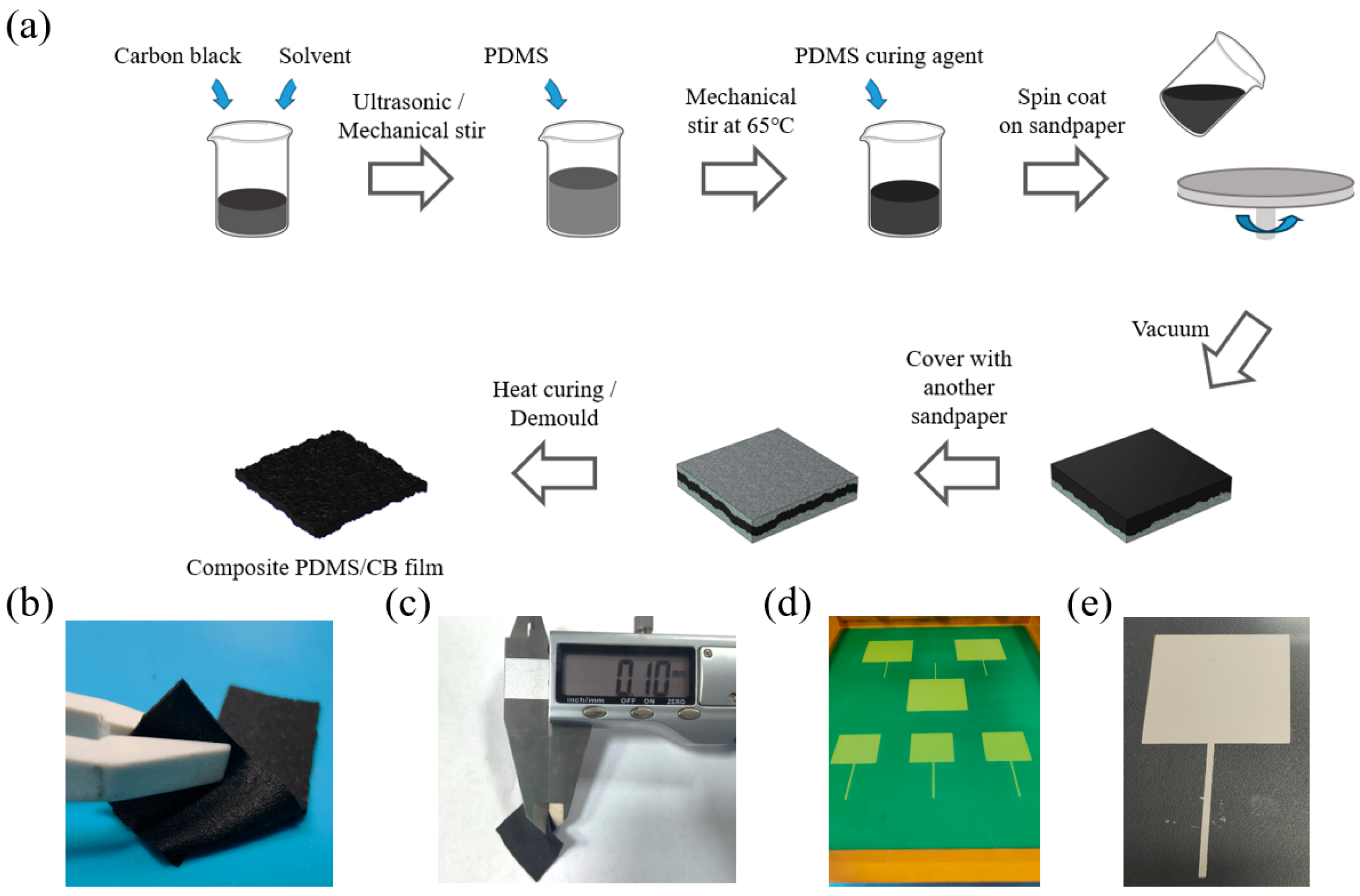

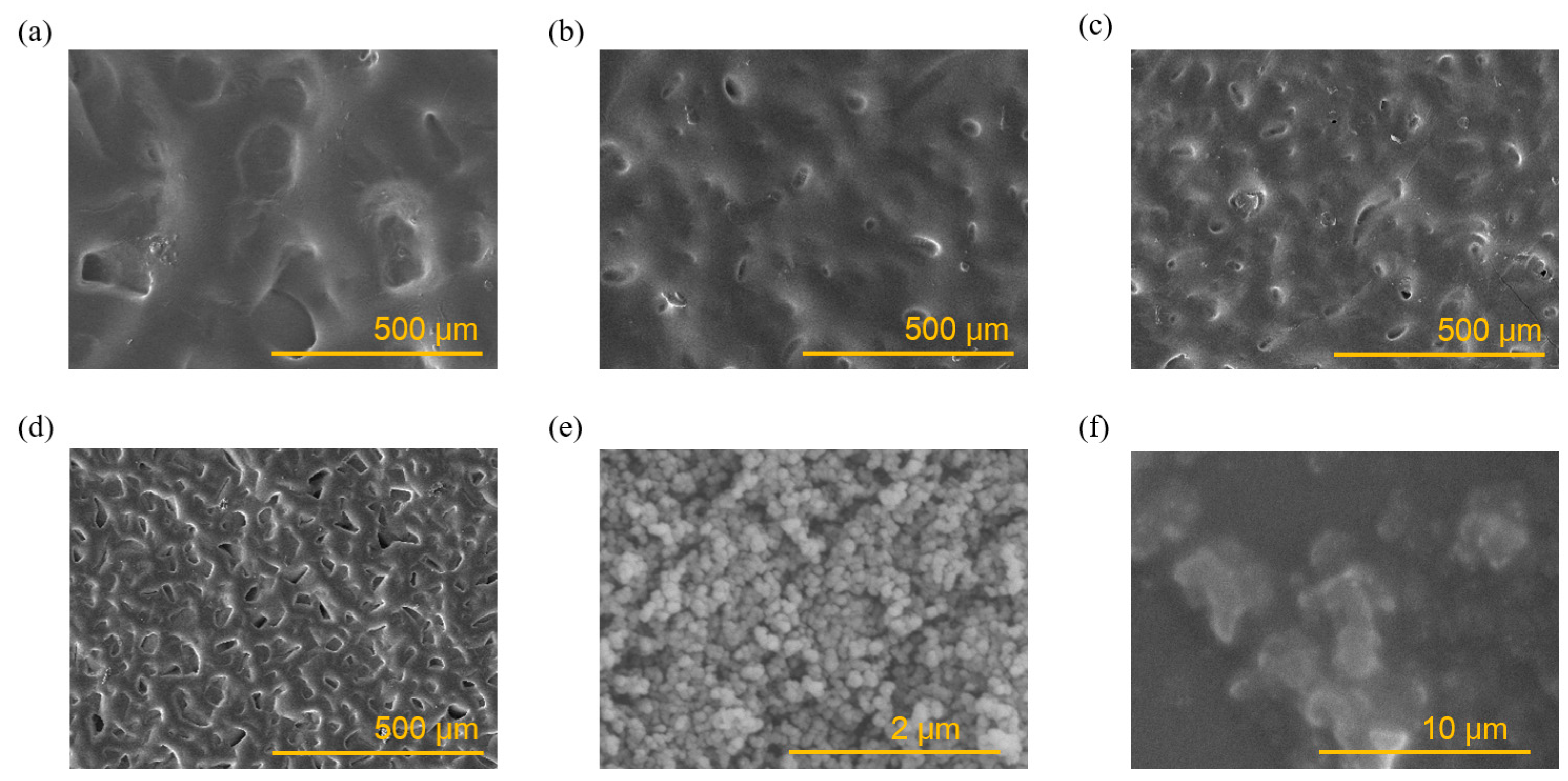

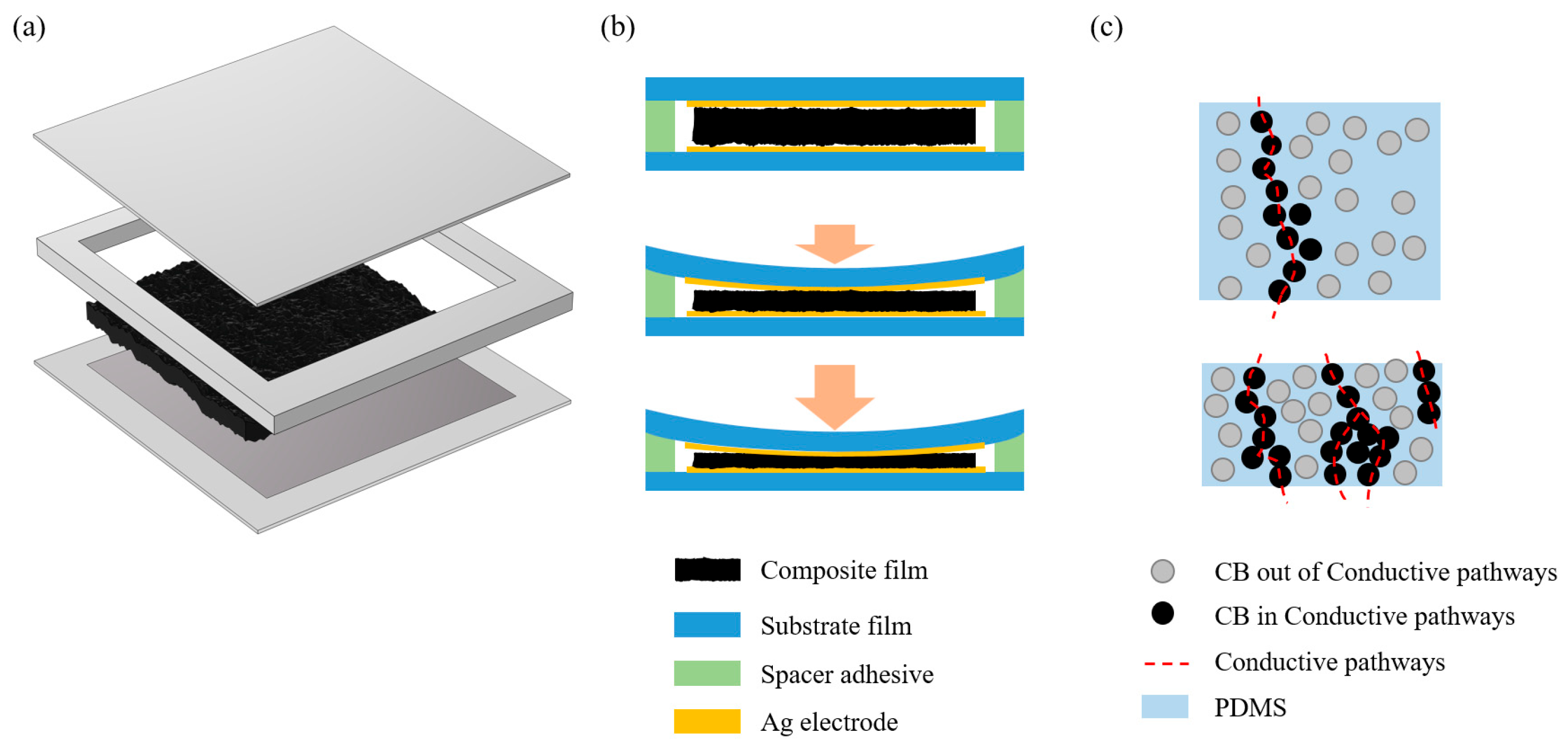


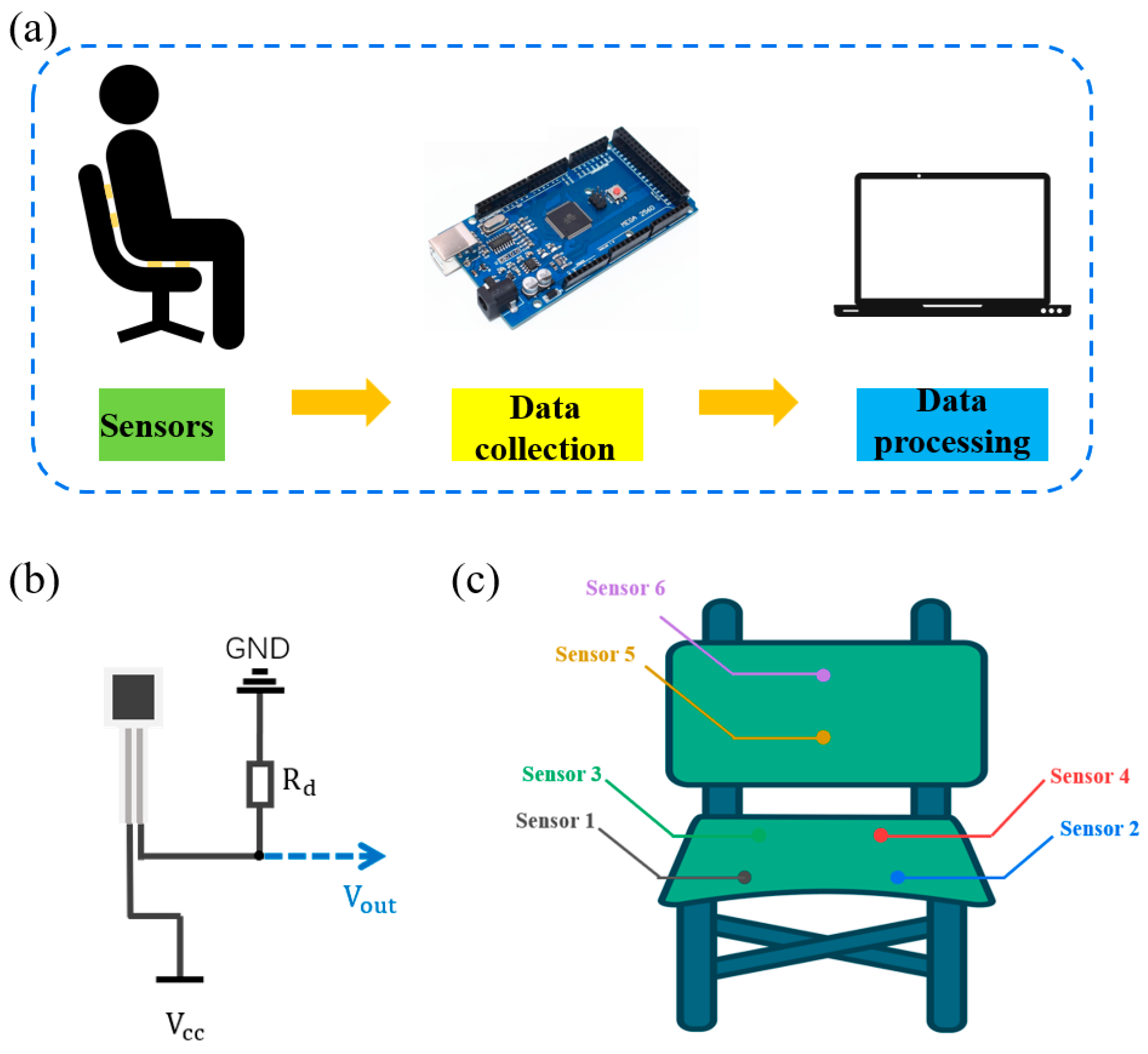
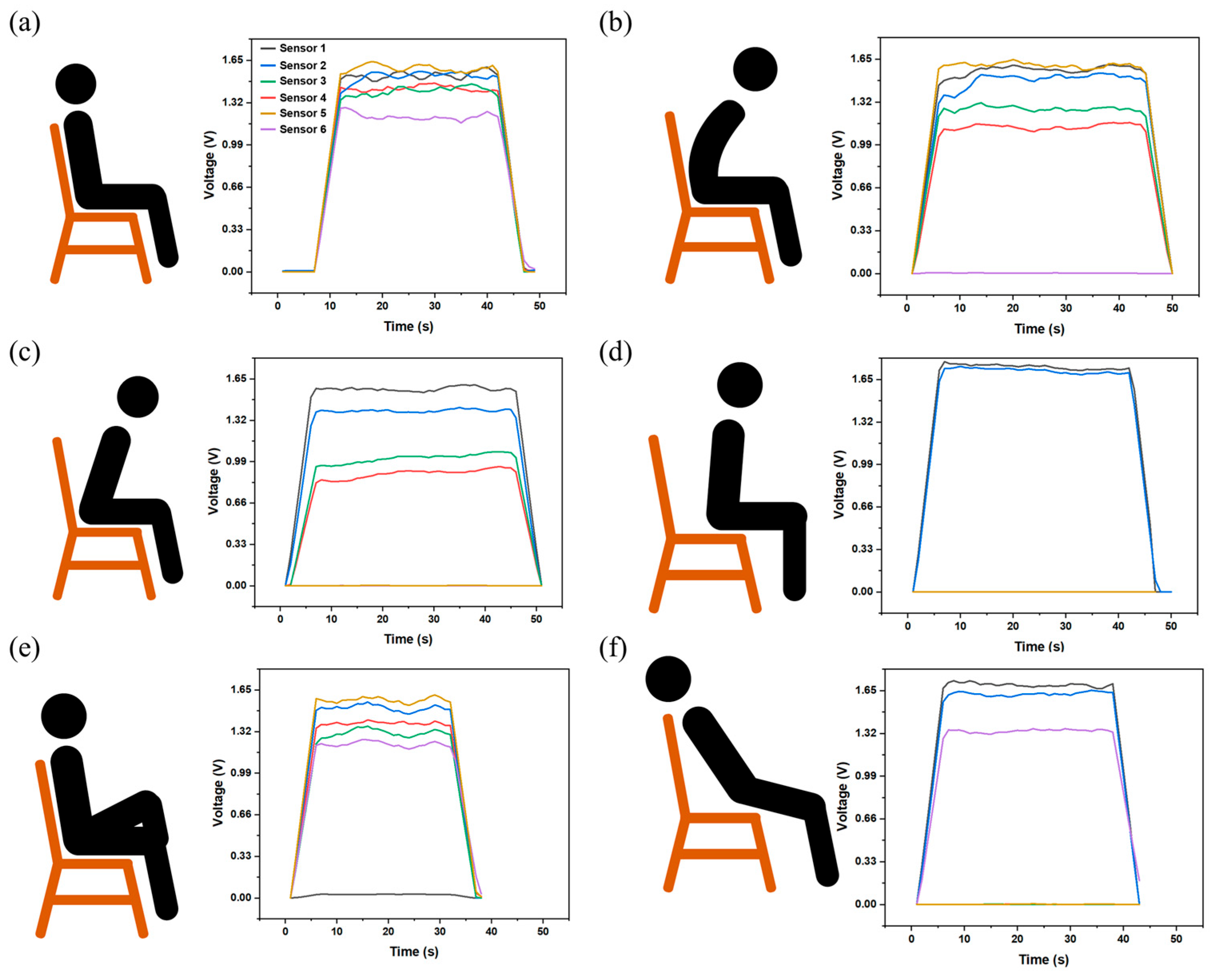
| Material | Structure | Sensitivity (kPa−1) | Response Range (kPa) | Ref. |
|---|---|---|---|---|
| MXene/graphene | Film | 2.13 | 10 | [37] |
| PDMS/PEDOT:PSS | Sandpaper | 2.32 | 100 | [38] |
| PDMS/SnSe2/MWCNTs | Lotus leaf | 165 | 80 | [39] |
| LIG | Film | 1.7 | 6 | [40] |
| LIG | Microspheres | 50 | 0.5 | [41] |
| Ag particle | Fiber | 4.55 | 10 | [42] |
| PEDOT:PSS | Textile | 6445 | 60 | [43] |
| MXene/SWCNT | Spheres | 2.6 | 7 | [44] |
| PDMS/CB | Sandpaper | 5.5 | 140 | This work |
Disclaimer/Publisher’s Note: The statements, opinions and data contained in all publications are solely those of the individual author(s) and contributor(s) and not of MDPI and/or the editor(s). MDPI and/or the editor(s) disclaim responsibility for any injury to people or property resulting from any ideas, methods, instructions or products referred to in the content. |
© 2024 by the authors. Licensee MDPI, Basel, Switzerland. This article is an open access article distributed under the terms and conditions of the Creative Commons Attribution (CC BY) license (https://creativecommons.org/licenses/by/4.0/).
Share and Cite
Sun, R.; Xiao, P.; Sun, L.; Guo, D.; Wang, Y. Flexible Piezoresistive Film Pressure Sensor Based on Double-Sided Microstructure Sensing Layer. Sensors 2024, 24, 8114. https://doi.org/10.3390/s24248114
Sun R, Xiao P, Sun L, Guo D, Wang Y. Flexible Piezoresistive Film Pressure Sensor Based on Double-Sided Microstructure Sensing Layer. Sensors. 2024; 24(24):8114. https://doi.org/10.3390/s24248114
Chicago/Turabian StyleSun, Rong, Peng Xiao, Lei Sun, Dongliang Guo, and Ye Wang. 2024. "Flexible Piezoresistive Film Pressure Sensor Based on Double-Sided Microstructure Sensing Layer" Sensors 24, no. 24: 8114. https://doi.org/10.3390/s24248114
APA StyleSun, R., Xiao, P., Sun, L., Guo, D., & Wang, Y. (2024). Flexible Piezoresistive Film Pressure Sensor Based on Double-Sided Microstructure Sensing Layer. Sensors, 24(24), 8114. https://doi.org/10.3390/s24248114






